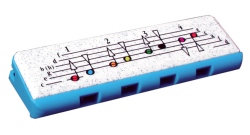 The Diatonic Scale
The Diatonic Scale
Imagine you were given a piano with no black keys. You could still produce a familiar do re mi scale and plenty of melodies using the key of C major, as this doesn’t require the sharps or flats of the black keys. Your white keyboard would effectively be a C diatonic keyboard, offering up the notes of the C major scale in each direction from Middle C. The notes of the C major scale are C D E F G A B and C again. That’s an eight note sequence, or octave. And it’s exactly what’s in our 10 hole diatonic C harp between holes 4 and 7. Try it for yourself 4B 4D 5B 5D 6B 6D 7D 7B. These are our melody, or soloing, notes.
The Chromatic Scale
If we reintroduced the black keys to our piano, it would become a chromatic keyboard, offering us the luxury of ascending and descending in half note steps. If we did so between two C keys an octave apart, the result would be:
Ascending : C C# D D# E F F# G G# A A# B C
Descending : C B Bb A Ab G Gb F E Eb D Db C
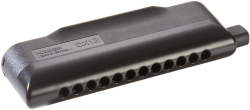 That’s a thirteen note sequence. And, just in case you’re wondering, yes C# is the same note as Db on a chromatic keyboard. This aspect of musical theory is called enharmonics; two names for the same note. Knowing exactly how, and exactly when to use each, is complicated theory we will save for a rainy day. On diatonic harmonicas, and on a bandstand however, you’ll normally hear the notes of the chromatic scale referred to as follows:
That’s a thirteen note sequence. And, just in case you’re wondering, yes C# is the same note as Db on a chromatic keyboard. This aspect of musical theory is called enharmonics; two names for the same note. Knowing exactly how, and exactly when to use each, is complicated theory we will save for a rainy day. On diatonic harmonicas, and on a bandstand however, you’ll normally hear the notes of the chromatic scale referred to as follows:
Common use : C Db D Eb E F F# G Ab A Bb B C
How to crack the modal code
Let’s return to our imaginary diatonic, or white key, piano for a moment. To break the routine of the C major scale outline above, we could experiment by ascending and descending between other like-notes an octave apart; D to D, or E to E for example. In doing so, we would be entering the magic kingdom of modal scales. Tabbing them for the 10 hole harp in sequence from C, the result is displayed in the chart below left. Take some time now to play each line left to right and right to left (up and down) a few times on your C harp. Listen carefully the end product in each case – the different character, or flavour, of each scale. How does each one leave you feeling? Can you find any useful or interesting musical licks? Do any of the scales remind you of tunes you have heard before?
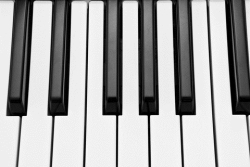 C 4B 4D 5B 5D 6B 6D 7D 7B
C 4B 4D 5B 5D 6B 6D 7D 7B
D 4D 5B 5D 6B 6D 7D 7B 8D
E 5B 5D 6B 6D 7D 7B 8D 8B
F 5D 6B 6D 7D 7B 8D 8B 9D
G 6B 6D 7D 7B 8D 8B 9D 9B
A 6D 7D 7B 8D 8B 9D 9B 10D
B 7D 7B 8D 8B 9D 9B 10D 10B
Now let’s analyse what’s actually happening by mapping out the musical steps, or intervals, we’re making in each case. Referring to the chromatic piano keyboard pictured above right will help you visualise what’s happening. We’ll call a whole-tone step T and a half-tone (or semi-tone) step s.
C T T s T T T s C D E F G A B C
D T s T T T s T D E F G A B C D
E s T T T s T T E F G A B C D E
F T T T s T T s F G A B C D E F
G T T s T T s T G A B C D E F G
A T s T T s T T A B C D E F G A
B s T T s T T T B C D E F G A B
And this is almost all you need to know – it’s that hard! In the left hand panel above, can you see how the semi-tone steps shift to the left each time we move up a mode? These are the intervals between E and F, and B and C. The right hand panel demonstrates this too. The semitone shifts are what changed the ‘flavour‘ of the modal scales you played earlier. They move closer to the start note each time; until they eventually become the start note.
modal scales you played earlier. They move closer to the start note each time; until they eventually become the start note.
Name and shame
I’ve used the term ‘flavour‘ with some forethought. I could have used ‘mood‘ but I don’t want to confuse this with mode, so let’s stick with the cooking metaphor for now. In which case, just as we’ve given each tone a letter of the alphabet, so each of the diatonic recipes above, or modal scales, has a given name:
C T T s T T T s Ionian
D T s T T T s T Dorian
E s T T T s T T Phrygian
F T T T s T T s Lydian
G T T s T T s T Mixolydian
A T s T T s T T Aeolian
B s T T s T T T Locrian
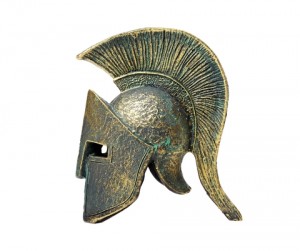 These are ancient Greek names. The Greeks recognised the science, art and magic of music. Indeed, music was actually part of the ancient Olympic Games. The Dorians were one of the four major Greek tribes and came from central Greece – they built temples with plane looking, Doric, capitals to their columns. Locrians were a minor tribe from north-west mainland Greece. Two of the other major Greek tribes were the Ionians who settled the Ionian seaboard in what is now Turkey, and the Aeolians, originally from Thessaly in mainland Greece. The Phrygian community was from Asia Minor (Turkey), as were the Lydians of Anatolia. Myxolydian means half, or almost, Lydian, and is a technical afterthought rather than an actual Greek tribe of small stature.
These are ancient Greek names. The Greeks recognised the science, art and magic of music. Indeed, music was actually part of the ancient Olympic Games. The Dorians were one of the four major Greek tribes and came from central Greece – they built temples with plane looking, Doric, capitals to their columns. Locrians were a minor tribe from north-west mainland Greece. Two of the other major Greek tribes were the Ionians who settled the Ionian seaboard in what is now Turkey, and the Aeolians, originally from Thessaly in mainland Greece. The Phrygian community was from Asia Minor (Turkey), as were the Lydians of Anatolia. Myxolydian means half, or almost, Lydian, and is a technical afterthought rather than an actual Greek tribe of small stature.
Nouvelle cuisine
Relating each of the modal scales to parts of the known world made the ‘flavour‘ of the mode more meaningful to the Greek listener. In the post-modern world we might call Phrygian the Spanish or Moorish mode, Lydian the Scottish mode, Aeolian the Klezmer or Yiddish mode and Dorian the English Folk mode. Meanwhile, philosophers ancient and modern might describe the ‘feeling‘ or ‘mood-changing‘ effect of each mode in the following way:
Ionian Harmonious or tender
Dorian Serious or melancholic
Phrygian Mystic
Lydian Happy or vibrant
Mixolydian Angelic or youthful
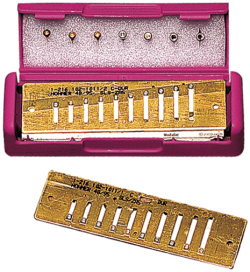 Aeolian Sad or tearful
Aeolian Sad or tearful
Locrian Wistful or yearning
Getting real with it
Now that the underlying theory is clearer, one glaringly important question arises; what practical use is there for musical modes while playing the diatonic harmonica? The answer in one word is, lots! But first let’s translate everything into harp speak.
To start with, it’s useful to equate each mode name with a standard key name. We’ll then need to agree a useful root note, or start point, for each key; officially called the point of resolution. Finally, it helps to find a memorable tune we can use as an aide memoire to recall each mode in a practical sense. Using a C harmonica, our shortlist might look like this:
Mode Key Root Note(s) Memorable tune
Ionian C major 4B, 1B, 7B, 10B When The Saints Go Marching In
Dorian D minor 4D, 1D, 8D Scarborough Fair
Phrygian E minor 5B, 2B, 8B Knights in White Satin (Moody Blues)
Lydian F major 5D, 9D, 2D” Au Claire de la Lune / Skye Boat Song
Mixolydian G major 2D, 6B, 9B Norwegian Wood (Beatles)
Aeolian A minor 6D, 3D”, 10D When Johnny Comes Marching Home
Locrian B diminished 3D, 7D She’s A Rainbow (Rolling Stones)
Running around in circles
Some of you may be thinking this is all very user-friendly, but you’d really like to get some engine oil under your fingernails. OK, roll your sleeves up, it’s time to haul the whole thing onto the inspection ramp. To truly relate the concept of modes to the 10 hole diatonic harp, we have to embrace a pivotal subject of musical of theory. It’s one that can quickly cause harp playing eyes to glaze over; the circle of fifths (or positional playing). Trust me when I say it’s really quite simple. If I can get it, so can you. Let’s gently set the ball rolling using a C harp.
We know we can play any number of straight harp tunes, including When The Saints Go Marching In, from 4B right? We also know this is called 1st Position. Well, to put it politely, these tunes soon feel pedestrian. We want to rock it up and play like Little Walter! So we find ourselves flipping through the next pages until we come to Cross Harp, where we adopt 2D as our root and range up and down between it and 6B. We then start to investigate draw bends. 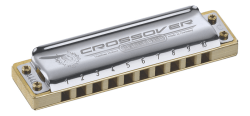 As we do so, we’re probably aware that we’re playing in G major. We also know this as 2nd Position.
As we do so, we’re probably aware that we’re playing in G major. We also know this as 2nd Position.
But let’s revisit what just happened for moment. To reach G from C, we’ve ascended 5 degrees, or notes, of the major scale. If we wanted to use posh musical vocabulary, we could call this a diatonic interval of 5. We’ve gone from C, through D E F up to G in 5 steps. Remember that we include the root note of C as step 1 when we start counting. It’s like the working week from Monday to Friday – five days in all. Hold that thought.
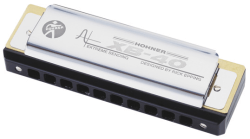
Step back baby, step back
Stepping back into modal terms for a moment (and once again if I can do this, you can too, so stay with it), we’ve moved from Ionian (C) out of root note 4B, to Mixolydian (G) out of root note 2D. Et voila! It’s that simple. We’ve worked our way from 1st to 2nd position, from 4B to 2D, from Ionian to Mixolydian and it’s all making sense. Ready for the next step?
If we counted up another interval of 5 from G, we’d reach D and that would be Dorian mode. Which is 3rd position from 4D. Hold up the fingers and thumb of either hand and double-check this: G A B C D. You just used your naturally patented, circle-of fifths, double-checking system. Take it with you whenever you play. By the way, to be absolutely accurate, we actually found D minor. We won’t explain the reason for this right now, as it will interrupt our line of thought. But once you’ve finished this page, had a massage and finished a cold glass of whatever takes your fancy, you can check it all out here.
Back on message. Position-wise, we can keep going round the circle of fifths using our fingers and thumbs until we eventually return to C. In doing so, we will have covered all twelve degrees of the chromatic scale. Or will we? I hear some of you asking ‘how come, when counting round in intervals of 5 takes us from C to G, G to D, D to A, A to E, E to B, B to F and finally from F to C? That’s only 7 notes on the keyboard, not 12!‘.
Better by half
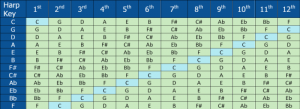 Here’s the solution. To be empirically accurate, we need to start counting not in diatonic intervals, but in chromatic intervals, or half steps only. This way the chromatic interval between C and G is 8 half-step degrees. The chromatic interval from G to D is also 8 half-step degrees. Only now, when we continue to count in this particular way, do we actually cover all 12 degrees of the chromatic scale; the white and black keys of our piano keyboard. Using the piano keyboard image above if necessary, let’s check it all out, ascending in 8 half-step intervals from C:
Here’s the solution. To be empirically accurate, we need to start counting not in diatonic intervals, but in chromatic intervals, or half steps only. This way the chromatic interval between C and G is 8 half-step degrees. The chromatic interval from G to D is also 8 half-step degrees. Only now, when we continue to count in this particular way, do we actually cover all 12 degrees of the chromatic scale; the white and black keys of our piano keyboard. Using the piano keyboard image above if necessary, let’s check it all out, ascending in 8 half-step intervals from C:
C G D A E B F# Db Ab Eb Bb F
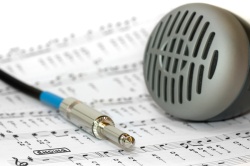
Well done! Here you have an absolute DNA blueprint for all twelve positions on a C major diatonic harmonica. You can take this same 8 half-step formula, apply it to any key of diatonic harmonica, and work out its integral twelve positional note names.
At the same time, you can confidently accept that you’ll encounter our seven modes as you go (in bold above). The modal positions also happen to be the most practical of the twelve options available to diatonic harp players – 1st, 2nd, 3rd, 4th, 5th, 6th and 12th – as the root note is not always hidden in an inconvenient bend. Now, just to round everything off, here are the 7 modes again with their root notes and corresponding position on the harmonica, again using a C major harp.
Mode Key Root Note(s) Harp Position
Ionian C major 4B, 1B, 7B, 10B 1st position
Dorian D minor 4D, 1D, 8D 3rd position
Phrygian E minor 5B, 2B, 8B 5th position
Lydian F major 5D, 9D, 2D” 12th position
Mixolydian G major 2D, 6B, 9B 2nd position
Aeolian A minor 6D, 3D”, 10D 4th position
Locrian B diminished 3D, 7D 6th position
Welcome to the human race!
If any of this is page unclear, it’s probably because you’re human, or else you’ve been playing your harmonica instinctively. The message is, it’s time to start playing smart as well as hard, so review the information above and add it to your arsenal. We guarantee it will help shape you into a musician. Very soon you’ll be surprising those who a*sumed you were ‘just the harp player’. Now read and re-read this page until you can comfortably do it all yourself. Then tell all your harp friends where you found the inspiration!
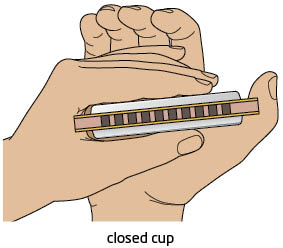
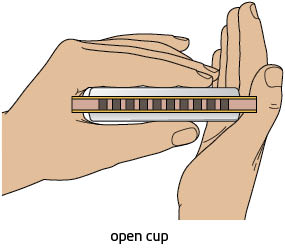
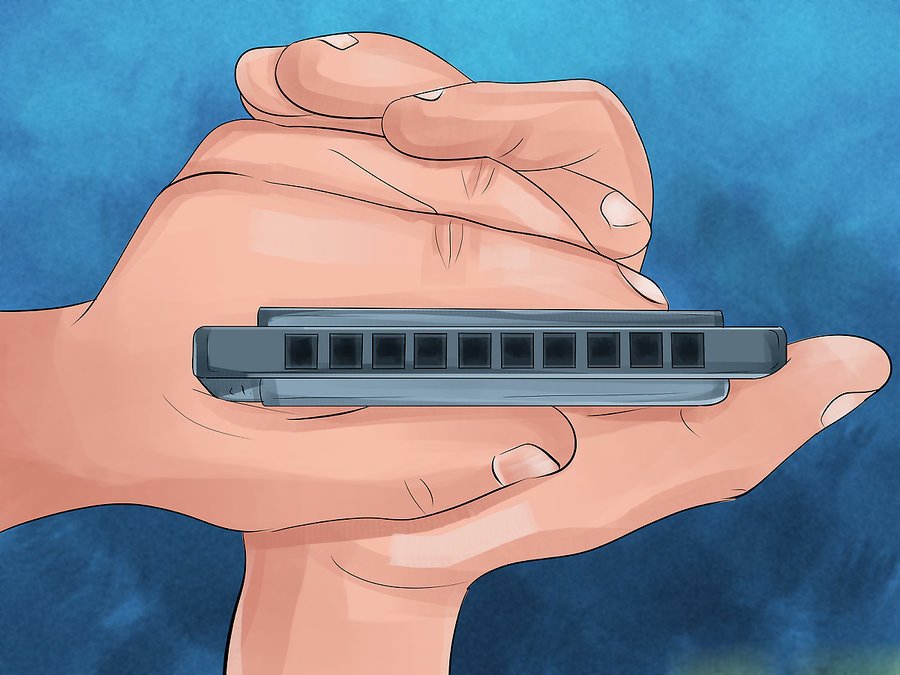

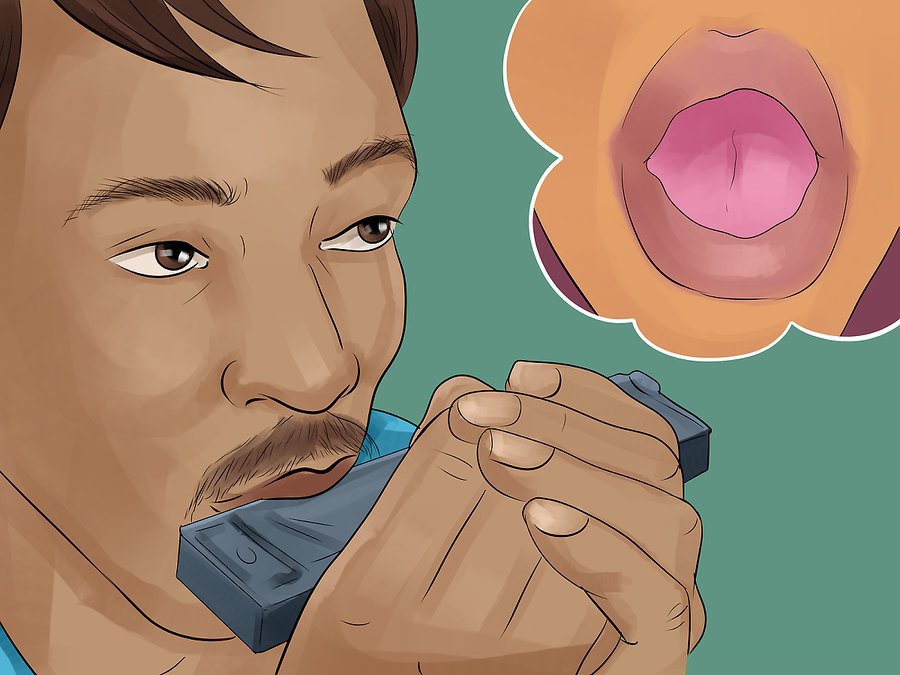
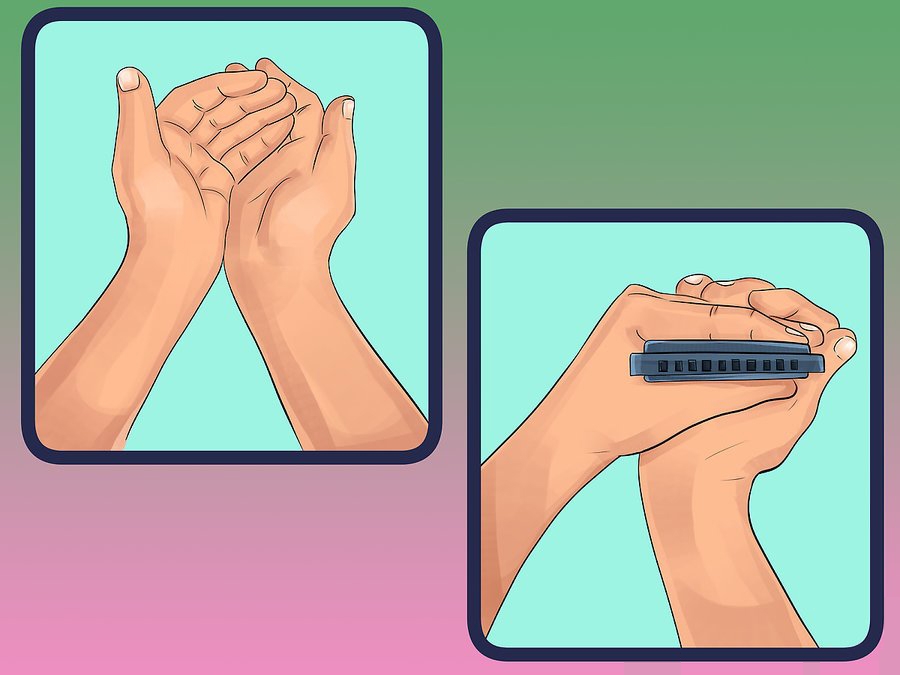
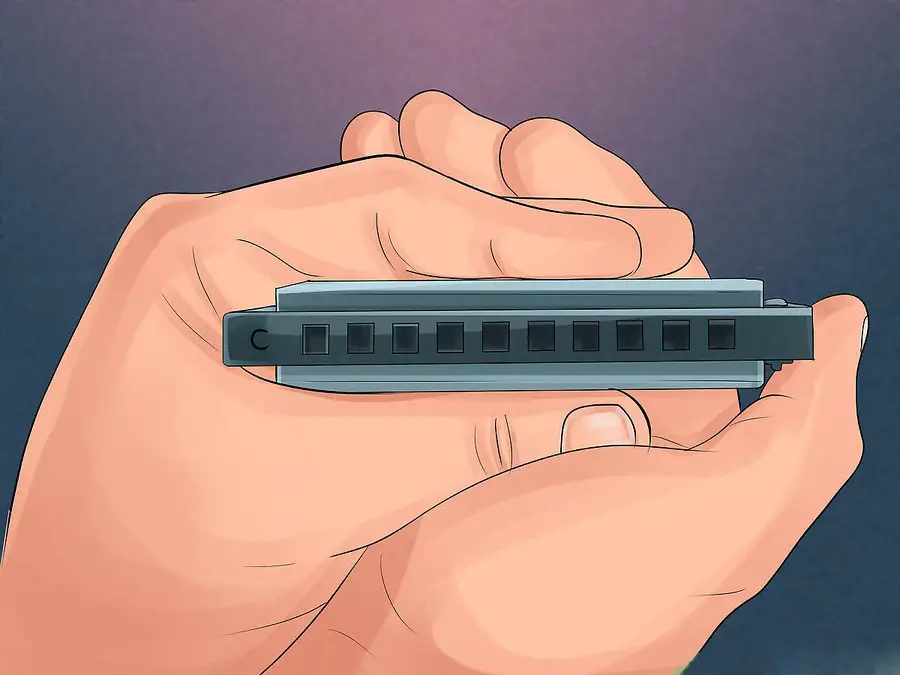
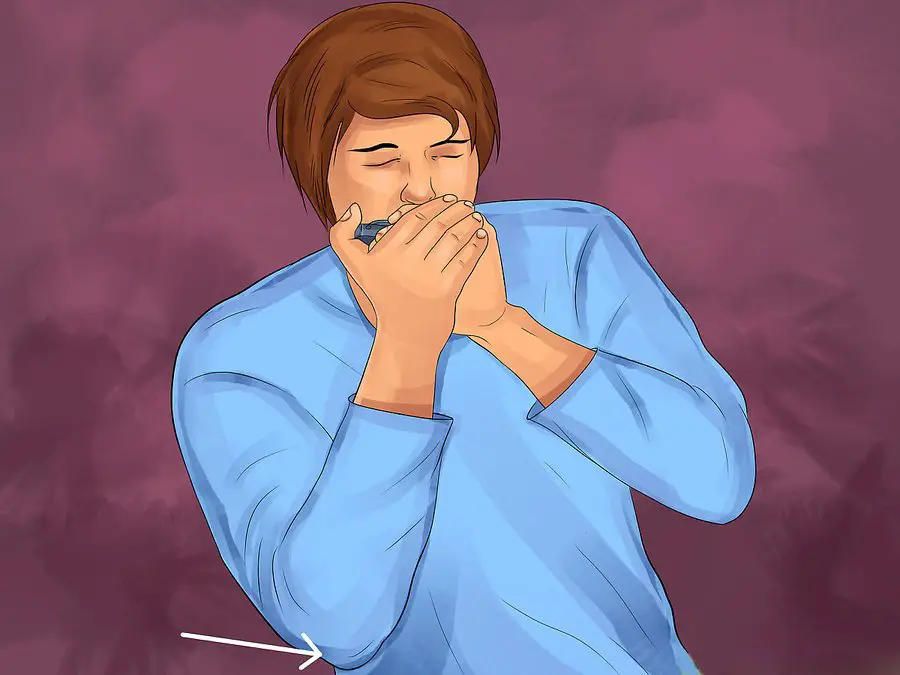
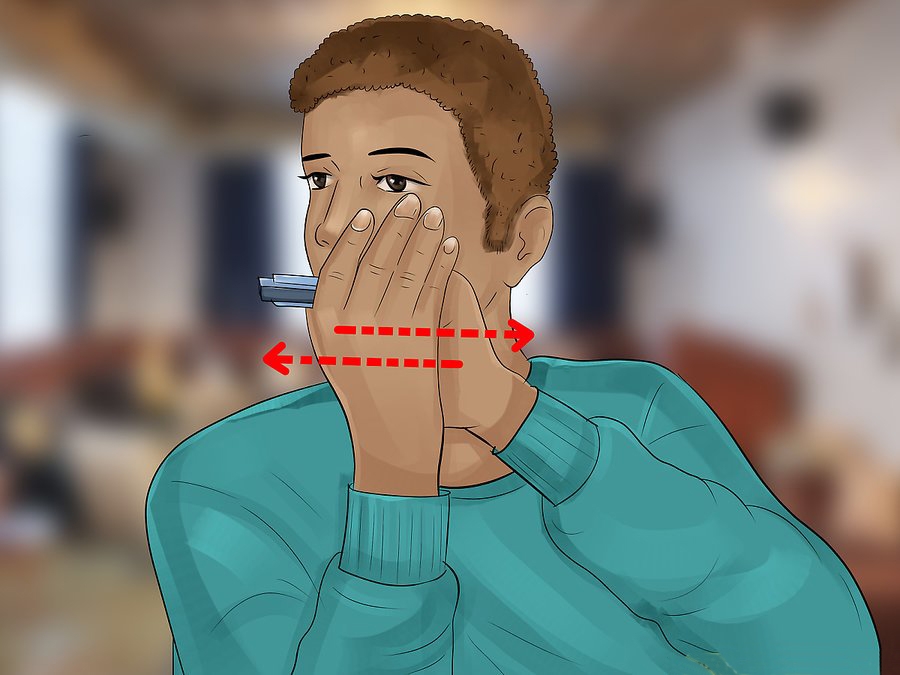
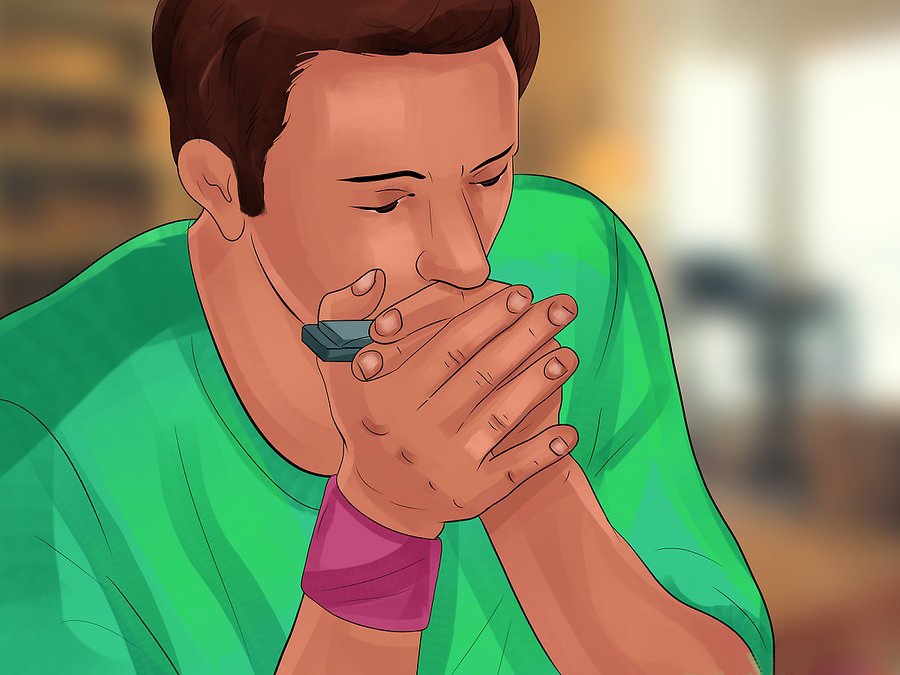
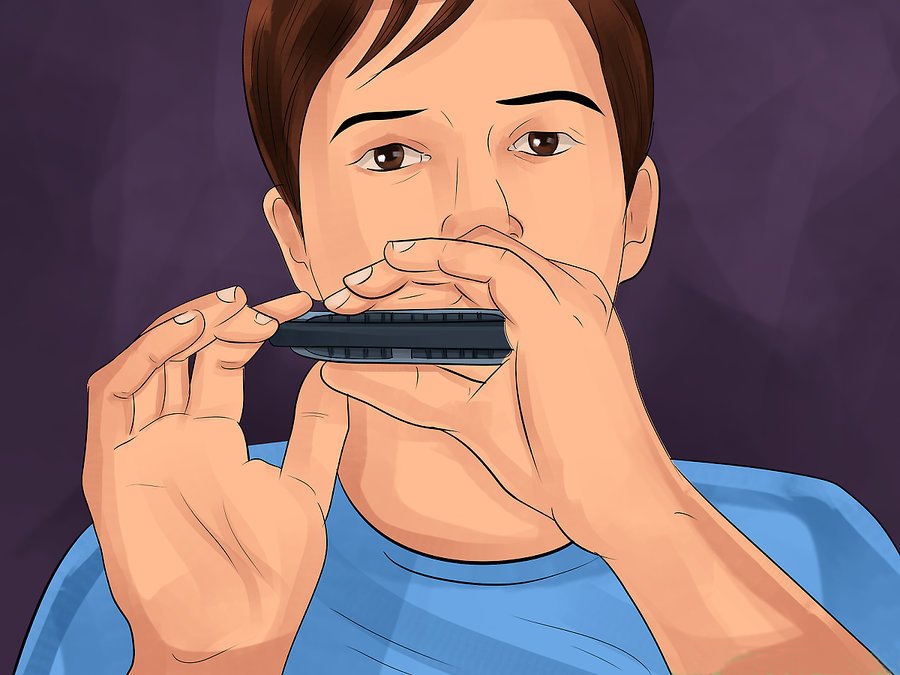
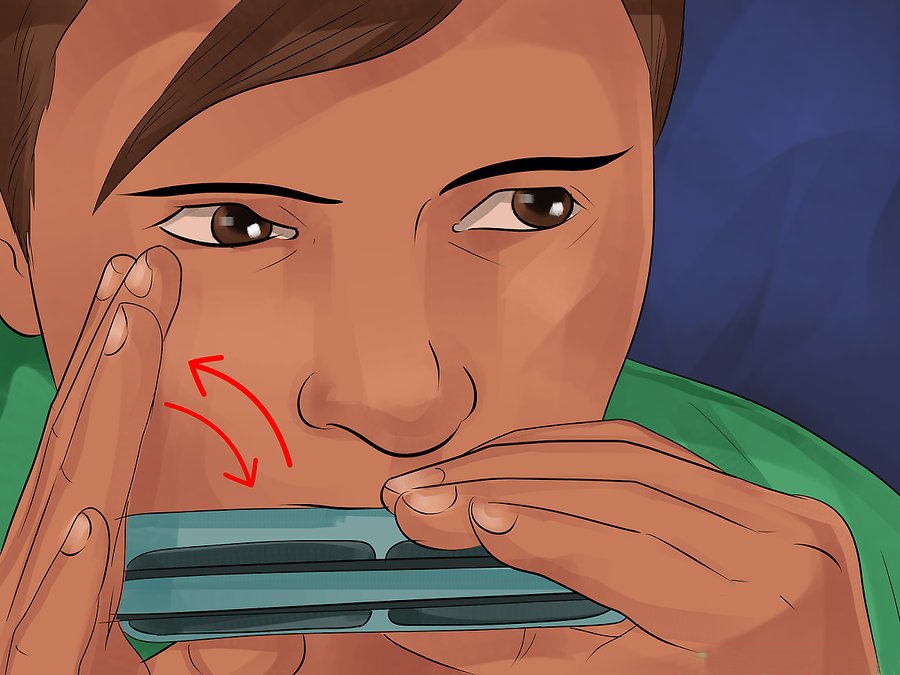
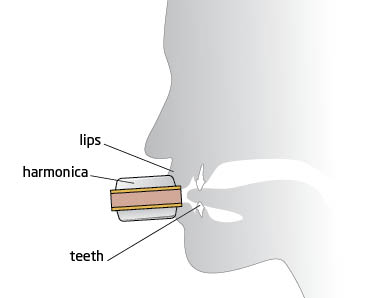
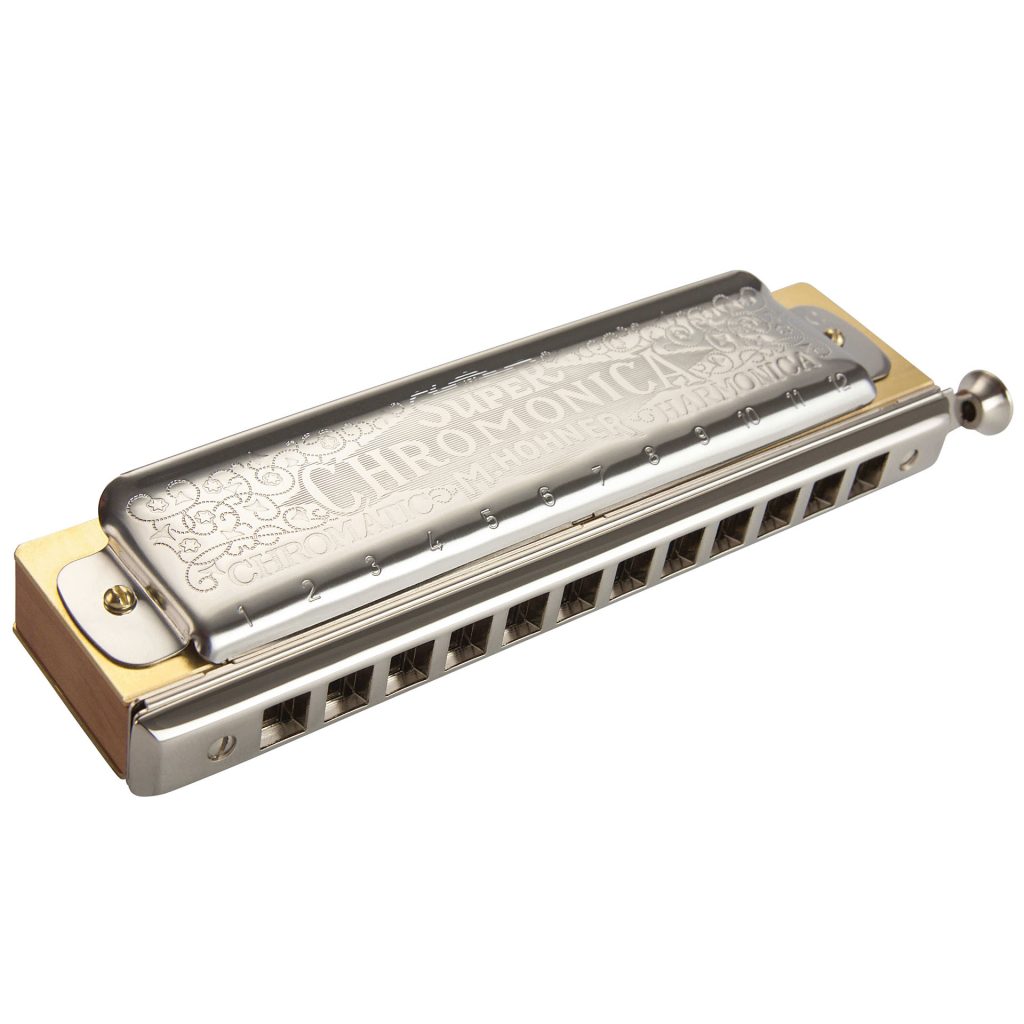

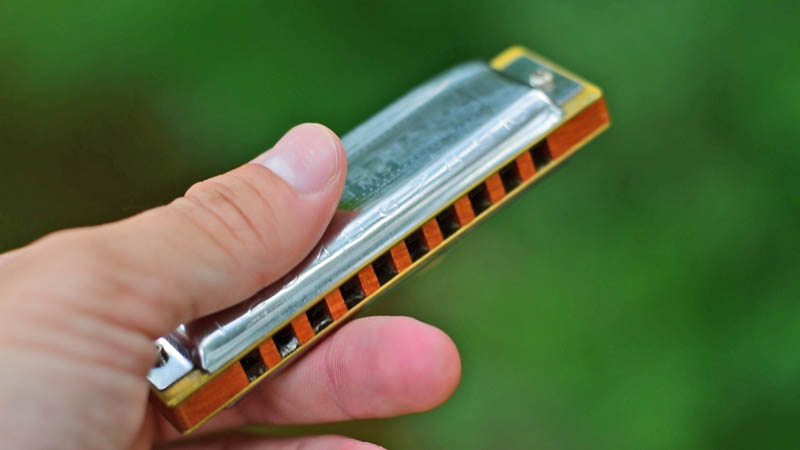


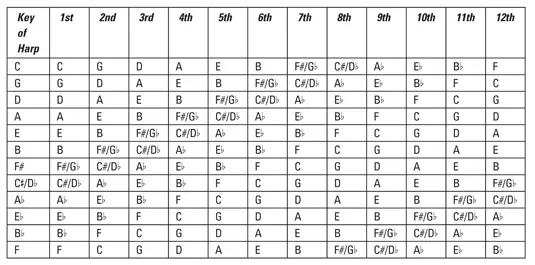
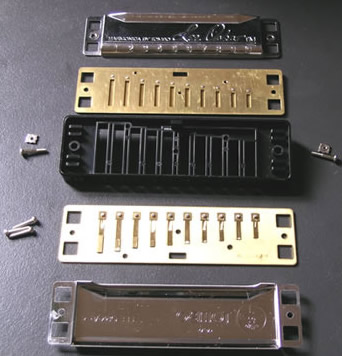
 The Diatonic Scale
The Diatonic Scale That’s a thirteen note sequence. And, just in case you’re wondering, yes
That’s a thirteen note sequence. And, just in case you’re wondering, yes  C 4B 4D 5B 5D 6B 6D 7D 7B
C 4B 4D 5B 5D 6B 6D 7D 7B modal scales you played earlier. They move closer to the start note each time; until they eventually become the start note.
modal scales you played earlier. They move closer to the start note each time; until they eventually become the start note. These are ancient Greek names. The Greeks recognised the science, art and magic of music. Indeed, music was actually part of the ancient Olympic Games. The Dorians were one of the four major Greek tribes and came from central Greece – they built temples with plane looking, Doric, capitals to their columns. Locrians were a minor tribe from north-west mainland Greece. Two of the other major Greek tribes were the Ionians who settled the Ionian seaboard in what is now Turkey, and the Aeolians, originally from Thessaly in mainland Greece. The Phrygian community was from Asia Minor (Turkey), as were the Lydians of Anatolia. Myxolydian means half, or almost, Lydian, and is a technical afterthought rather than an actual Greek tribe of small stature.
These are ancient Greek names. The Greeks recognised the science, art and magic of music. Indeed, music was actually part of the ancient Olympic Games. The Dorians were one of the four major Greek tribes and came from central Greece – they built temples with plane looking, Doric, capitals to their columns. Locrians were a minor tribe from north-west mainland Greece. Two of the other major Greek tribes were the Ionians who settled the Ionian seaboard in what is now Turkey, and the Aeolians, originally from Thessaly in mainland Greece. The Phrygian community was from Asia Minor (Turkey), as were the Lydians of Anatolia. Myxolydian means half, or almost, Lydian, and is a technical afterthought rather than an actual Greek tribe of small stature.
 As we do so, we’re probably aware that we’re playing in
As we do so, we’re probably aware that we’re playing in 
 Here’s the solution. To be empirically accurate, we need to start counting not in diatonic intervals, but in chromatic intervals, or half steps only. This way the chromatic interval between
Here’s the solution. To be empirically accurate, we need to start counting not in diatonic intervals, but in chromatic intervals, or half steps only. This way the chromatic interval between 
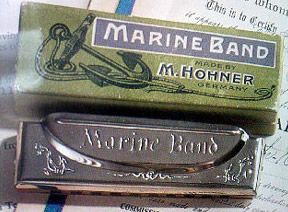
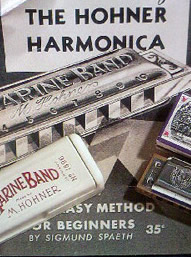 Why harp?
Why harp?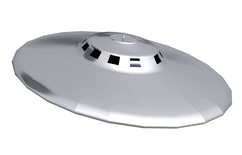 Close encounters of the third kind
Close encounters of the third kind 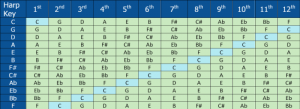 So what are positions all about? In the simplest terms, we can take a C major harmonica and use it to play in different keys just by using a different hole as our root note, or starting point, each time. Some keys will be more useful than others, but in theory we could start from any natural, sharp or flat note (black or white key on the piano) and find some fun phrases. In doing so we are inadvertently working in different musical positions. By way of example, When The Saints works well from 4B, Juke works well from 2D, Summertime works well from 4D and Au Claire De La Lune is best played from 5D. To forge an answer to our original question however, we need to apply some logic and find a workable formula or DNA to explain what’s going on. Why? Because it will enable us to express ourselves as musicians rather than just harmonica players. And with this comes greater understanding and enjoyment of our instrument and music in general. The solution is where music and maths collide in the form of the circle of fifths.
So what are positions all about? In the simplest terms, we can take a C major harmonica and use it to play in different keys just by using a different hole as our root note, or starting point, each time. Some keys will be more useful than others, but in theory we could start from any natural, sharp or flat note (black or white key on the piano) and find some fun phrases. In doing so we are inadvertently working in different musical positions. By way of example, When The Saints works well from 4B, Juke works well from 2D, Summertime works well from 4D and Au Claire De La Lune is best played from 5D. To forge an answer to our original question however, we need to apply some logic and find a workable formula or DNA to explain what’s going on. Why? Because it will enable us to express ourselves as musicians rather than just harmonica players. And with this comes greater understanding and enjoyment of our instrument and music in general. The solution is where music and maths collide in the form of the circle of fifths.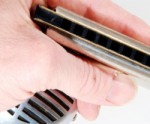 Thumbing a lift
Thumbing a lift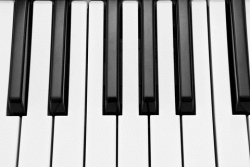 Beam me up Scotty
Beam me up Scotty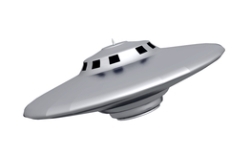 Now let’s move up to G from C for second position using the circle of fifths and follow the same process. To play the G major triad on the diatonic (white key only) keyboard, we’d place our thumb on G as the root note this time, our middle finger on B and our little finger on D. Once again we’d have a satisfying and complete sound. Try it by playing 2D-3D-4D together. And again we’ve used the first, third and fifth degrees (notes) of the G major scale. And that’s second position nailed. But again let’s reinforce things by playing the G major arpeggio up and down: 2D 3D 4D 6B 4D 3D 2D
Now let’s move up to G from C for second position using the circle of fifths and follow the same process. To play the G major triad on the diatonic (white key only) keyboard, we’d place our thumb on G as the root note this time, our middle finger on B and our little finger on D. Once again we’d have a satisfying and complete sound. Try it by playing 2D-3D-4D together. And again we’ve used the first, third and fifth degrees (notes) of the G major scale. And that’s second position nailed. But again let’s reinforce things by playing the G major arpeggio up and down: 2D 3D 4D 6B 4D 3D 2D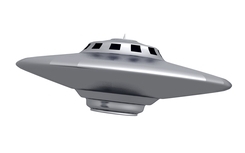 into F# rather than F. But we don’t really have an F# because we’re using a diatonic keyboard remember? White keys only. F# is most definitely a black key. So we’re kind of stuck with what we’ve got.
into F# rather than F. But we don’t really have an F# because we’re using a diatonic keyboard remember? White keys only. F# is most definitely a black key. So we’re kind of stuck with what we’ve got.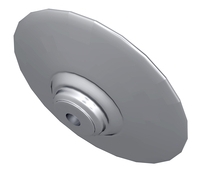
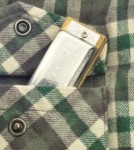 G’night John Boy!
G’night John Boy!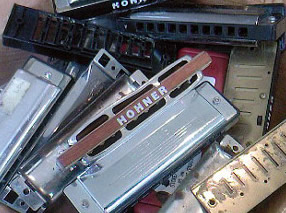 Where can I get one?
Where can I get one?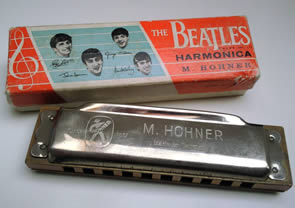 There are so many types of harmonica on offer it can be bewildering at first. Without a doubt you need to start with a standard 10 hole diatonic (commonly called a blues style harmonica or short harp). THis is what the majority of players use for blues, rock, country, folk and celtic. The bulk of non-chromatic reference material is built round this type of harp. It’s going to take time to learn any harp at first, so at this stage the brand is not too important. They’ll all present you with the same obstacles as a beginner. Later on you can try different makes and models and begin to establish your favourites. Ultimately it’s down to personal taste. One man’s tin sandwich is another man’s gob iron. Most retailers will stock Lee Oskars or Hohners. These are fine.
There are so many types of harmonica on offer it can be bewildering at first. Without a doubt you need to start with a standard 10 hole diatonic (commonly called a blues style harmonica or short harp). THis is what the majority of players use for blues, rock, country, folk and celtic. The bulk of non-chromatic reference material is built round this type of harp. It’s going to take time to learn any harp at first, so at this stage the brand is not too important. They’ll all present you with the same obstacles as a beginner. Later on you can try different makes and models and begin to establish your favourites. Ultimately it’s down to personal taste. One man’s tin sandwich is another man’s gob iron. Most retailers will stock Lee Oskars or Hohners. These are fine.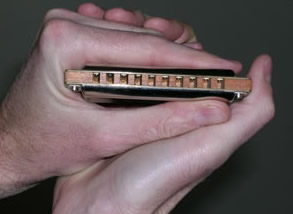 The outer curve of your left thumb should fit nicely onto the ball of your right thumb (see image). I call this the ‘hinge’. Now cup your right hand around the back of the harp to form a chamber. This is the classic hand hold.
The outer curve of your left thumb should fit nicely onto the ball of your right thumb (see image). I call this the ‘hinge’. Now cup your right hand around the back of the harp to form a chamber. This is the classic hand hold. Airtight seal
Airtight seal Don’t put up with cheap imitations. If it sounds like a car horn, you’re catching too many holes. If it sounds clean you’re where you need to be. Use your ears and listen to what’s going on. Incidentally, in order to locate the note you want, don’t be afraid to use the tip of your tongue to count up from 1 or down from 10. It’s a legitimate process. Get sloppy. Your harp enjoys intimacy remember.
Don’t put up with cheap imitations. If it sounds like a car horn, you’re catching too many holes. If it sounds clean you’re where you need to be. Use your ears and listen to what’s going on. Incidentally, in order to locate the note you want, don’t be afraid to use the tip of your tongue to count up from 1 or down from 10. It’s a legitimate process. Get sloppy. Your harp enjoys intimacy remember.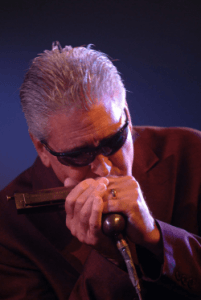 This is the next important concept to take on board. You need an open mouth cavity and vocal tract. So imagine you have a hard boiled egg, or a hot new potato, in your mouth as you play. Resist the temptation of bringing your tongue into the equation. Pretend to yawn. That’s where your tongue should be. Otherwise try speaking like Mr Bean for a while.
This is the next important concept to take on board. You need an open mouth cavity and vocal tract. So imagine you have a hard boiled egg, or a hot new potato, in your mouth as you play. Resist the temptation of bringing your tongue into the equation. Pretend to yawn. That’s where your tongue should be. Otherwise try speaking like Mr Bean for a while.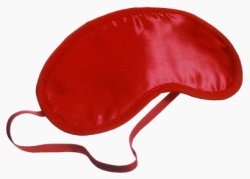 If you can’t hear it yet, go back to the start and work through again. It’s worth it. Playing one note with the best possible tone beats loads of weak notes every time. Think cricket or baseball. Listen to the sound you’re making and find the meat of the bat. The sweet spot. You know when you’ve found it because it will ring in your ears and fill the room. You will hear a full, rounded and, above all, warm sound quality.
If you can’t hear it yet, go back to the start and work through again. It’s worth it. Playing one note with the best possible tone beats loads of weak notes every time. Think cricket or baseball. Listen to the sound you’re making and find the meat of the bat. The sweet spot. You know when you’ve found it because it will ring in your ears and fill the room. You will hear a full, rounded and, above all, warm sound quality.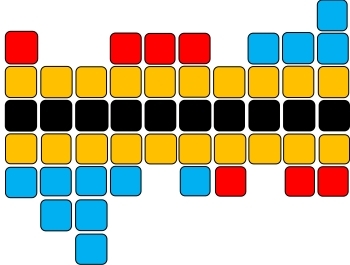 There is no doubt that learning to draw bend marks the transition from beginner to intermediate harmonica playing. When we find our first bend, it feels like we’ve just won the lottery. After hours of perseverance, we’re punching the air and yelling ‘woohoo’ like Homer Simpson. We want to tell all our friends. We want to start a band too. And fair play; bending is what gives the diatonic harmonica it’s signature sound. We can now start to learn the coolest licks and enjoy a new universe of musical expression. This was probably the reason we chose to play the harmonica in the first place.
There is no doubt that learning to draw bend marks the transition from beginner to intermediate harmonica playing. When we find our first bend, it feels like we’ve just won the lottery. After hours of perseverance, we’re punching the air and yelling ‘woohoo’ like Homer Simpson. We want to tell all our friends. We want to start a band too. And fair play; bending is what gives the diatonic harmonica it’s signature sound. We can now start to learn the coolest licks and enjoy a new universe of musical expression. This was probably the reason we chose to play the harmonica in the first place.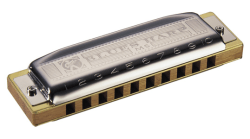 your 10 hole harmonica now. There is a logical explanation for this duplication, which we cover in Why are 2 draw and 3 blow the same?, but for now, let’s get back to drawing board.
your 10 hole harmonica now. There is a logical explanation for this duplication, which we cover in Why are 2 draw and 3 blow the same?, but for now, let’s get back to drawing board.
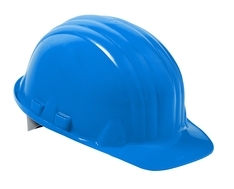 bends on hold and learn this essential skill first. You’ll be glad you did.
bends on hold and learn this essential skill first. You’ll be glad you did.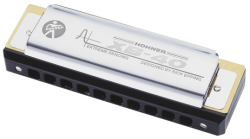 many blow bends are there? Where are they all? Can you play them individually and accurately? Do you know what direct bends are? Are there bends in holes 5 and 7? What about hole 10? Which reed bends when we play a draw bend? What’s happening in each chamber when a bend takes place? What is the tonal theory behind bends? Be honest, because one thing’s certain: if you take time to perfect every aspect of bending from a knowledge perspective as well as a practical one, you’ll have built foundations that are far more solid than errant cohorts of other players. So let’s roll up our sleeves and let’s enjoy the journey to enlightenment.
many blow bends are there? Where are they all? Can you play them individually and accurately? Do you know what direct bends are? Are there bends in holes 5 and 7? What about hole 10? Which reed bends when we play a draw bend? What’s happening in each chamber when a bend takes place? What is the tonal theory behind bends? Be honest, because one thing’s certain: if you take time to perfect every aspect of bending from a knowledge perspective as well as a practical one, you’ll have built foundations that are far more solid than errant cohorts of other players. So let’s roll up our sleeves and let’s enjoy the journey to enlightenment.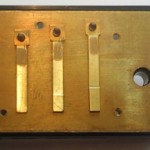 or channel. It is the interaction between these two reeds that is the source of bending. Valving reeds interrupts this process, which is why it is difficult to play bends on a chromatic harmonica. Where there is a difference in pitch between the two reeds of one full tone or more, physics says the potential for a half step bend has been created. As this difference in pitch, or interval, increases by an additional semitone, so an extra semitone bend is facilitated.
or channel. It is the interaction between these two reeds that is the source of bending. Valving reeds interrupts this process, which is why it is difficult to play bends on a chromatic harmonica. Where there is a difference in pitch between the two reeds of one full tone or more, physics says the potential for a half step bend has been created. As this difference in pitch, or interval, increases by an additional semitone, so an extra semitone bend is facilitated.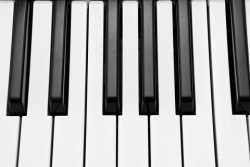 keys on the piano keyboard, if there are one or more other keys separating them you’ll find the equivalent bend, or bends, in the harmonica. So for example
keys on the piano keyboard, if there are one or more other keys separating them you’ll find the equivalent bend, or bends, in the harmonica. So for example 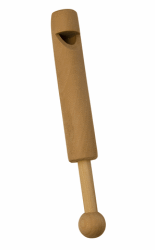 encounter blow bends. But here’s the surprise – while the sensation of bending feels like we are dragging the higher reed down with our breath, the truth is the exact opposite. If you could watch the reeds while you played a bend, you’d actually notice the lower pitched reed moving more than the higher one. This is because the technique required to work the bend alters the air pressure across both reeds, effectively ‘neutralising’ the higher reed, as the lower reed moves ‘in sympathy’.
encounter blow bends. But here’s the surprise – while the sensation of bending feels like we are dragging the higher reed down with our breath, the truth is the exact opposite. If you could watch the reeds while you played a bend, you’d actually notice the lower pitched reed moving more than the higher one. This is because the technique required to work the bend alters the air pressure across both reeds, effectively ‘neutralising’ the higher reed, as the lower reed moves ‘in sympathy’.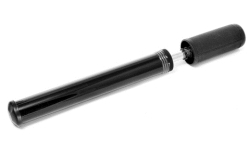 or bend in the tone results.
or bend in the tone results.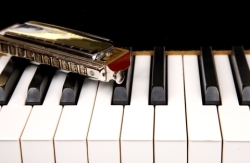 bent note. The greater the interval the greater the number of bent notes. Picture a piano. You have white and black keys. Consider the scale of C major (do re mi etc). It comprises eight full tones (the white keys) or a total of thirteen half tone steps (white and black keys). Moving from
bent note. The greater the interval the greater the number of bent notes. Picture a piano. You have white and black keys. Consider the scale of C major (do re mi etc). It comprises eight full tones (the white keys) or a total of thirteen half tone steps (white and black keys). Moving from 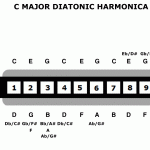 Our diagram of a C diatonic harmonica shows you which notes are found in each hole (click it to enlarge). Using a standard scale of chromatic notes, or a piano keyboard, we should be able to calculate the number of bends in each hole and their names. Here’s the chromatic sequence starting from A:
Our diagram of a C diatonic harmonica shows you which notes are found in each hole (click it to enlarge). Using a standard scale of chromatic notes, or a piano keyboard, we should be able to calculate the number of bends in each hole and their names. Here’s the chromatic sequence starting from A: 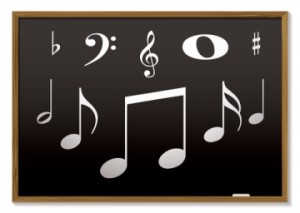 B, so there are three semitones between (
B, so there are three semitones between ( Your passport to heaven
Your passport to heaven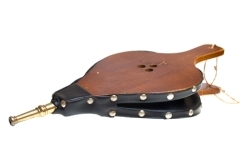 Your lips shouldn’t spread wider or change shape as you bend. They are there to maintain a good seal around the target area. Loose air means no bend. The bending process then begins in your vocal tract and in your mind. By anticipating the bent note the rest will follow. It’s how we pitch our notes when we sing or whistle. The reeds replace your vocal chords!
Your lips shouldn’t spread wider or change shape as you bend. They are there to maintain a good seal around the target area. Loose air means no bend. The bending process then begins in your vocal tract and in your mind. By anticipating the bent note the rest will follow. It’s how we pitch our notes when we sing or whistle. The reeds replace your vocal chords!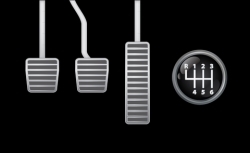 This the bite point. When you learn to drive a manual car, you have to synchronise the clutch and accelerator (gas) pedals in order to engage the engine and pull forward. Miss the bite point and you stall the engine or the car kangaroos up the street. This is because you’re slipping the clutch. Learn to recognise the bite point as each bend engages. And as soon as the bend cuts in, increase the pull from your throat and chest. Attack it! Eventually you will feel the reed drop into a whole new position and the pitch will drop with it. If you overshoot the bite point, don’t hang on fruitlessly. This is wasted effort. Let it all go and start again.
This the bite point. When you learn to drive a manual car, you have to synchronise the clutch and accelerator (gas) pedals in order to engage the engine and pull forward. Miss the bite point and you stall the engine or the car kangaroos up the street. This is because you’re slipping the clutch. Learn to recognise the bite point as each bend engages. And as soon as the bend cuts in, increase the pull from your throat and chest. Attack it! Eventually you will feel the reed drop into a whole new position and the pitch will drop with it. If you overshoot the bite point, don’t hang on fruitlessly. This is wasted effort. Let it all go and start again.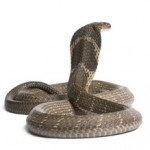 Sounds like quite a partay! But seriously, sometimes it helps to imagine yourself pulling thick milkshake through a straw, or sucking venom from a snake bite. The sucking or plunger process created by the tongue is integral to draw bending on the harmonica. If shakes and snakes don’t do it for you though, picture a standard bicycle pump. As you pull the top end of the pump, it draws in air. You’re doing the same on the harmonica with your tongue acting as the pump.
Sounds like quite a partay! But seriously, sometimes it helps to imagine yourself pulling thick milkshake through a straw, or sucking venom from a snake bite. The sucking or plunger process created by the tongue is integral to draw bending on the harmonica. If shakes and snakes don’t do it for you though, picture a standard bicycle pump. As you pull the top end of the pump, it draws in air. You’re doing the same on the harmonica with your tongue acting as the pump.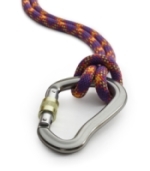 I make no apology if abseiling and reed bending appear totally unrelated. However, you will understand this analogy if you have actually abseiled; especially if you can recall the very first time. When you leaned back into nothing with only a rope to keep you from falling, your heart was racing and you felt a rush of adrenalin. Well note bending is a similar leap of faith. You don’t know what you’re trying to find, whether you’ll get there in one piece, or what it’ll be like on the way down, but once you make the break through, it feels fantastic. So lean back and take the reed with you. All the way to the bottom.
I make no apology if abseiling and reed bending appear totally unrelated. However, you will understand this analogy if you have actually abseiled; especially if you can recall the very first time. When you leaned back into nothing with only a rope to keep you from falling, your heart was racing and you felt a rush of adrenalin. Well note bending is a similar leap of faith. You don’t know what you’re trying to find, whether you’ll get there in one piece, or what it’ll be like on the way down, but once you make the break through, it feels fantastic. So lean back and take the reed with you. All the way to the bottom.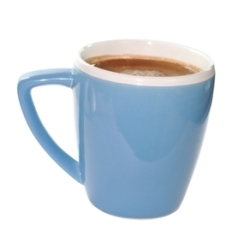 To get used to the transfer of control centres when attempting low end draw bends in hols 1, 2 and 3, consider the way you might drink a cup of hot chocolate. Initially you’re going to sip the froth using your lips, the tip of your tongue and a tug of air between your teeth. As the sipped liquid cools in your mouth, you’re then ready to swallow it. Sipping and swallowing are the start and end control points of low end draw bends. In time, as your throat muscles strengthen, you’ll learn to pull directly from the vocal tract. The 4D’ and 6D’ bends are one shorter reeds however, and the control point tends to remain further forward in the mouth.
To get used to the transfer of control centres when attempting low end draw bends in hols 1, 2 and 3, consider the way you might drink a cup of hot chocolate. Initially you’re going to sip the froth using your lips, the tip of your tongue and a tug of air between your teeth. As the sipped liquid cools in your mouth, you’re then ready to swallow it. Sipping and swallowing are the start and end control points of low end draw bends. In time, as your throat muscles strengthen, you’ll learn to pull directly from the vocal tract. The 4D’ and 6D’ bends are one shorter reeds however, and the control point tends to remain further forward in the mouth.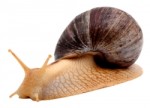 to treat each bent note as an individual piano key. This is called direct bending. To master this skill, start by moving between a clean draw and a full bend, down and up, as slowly as possible. This will help you develop muscle memory and strengthen your bending technique. In the holes that have more than one bent note,
to treat each bent note as an individual piano key. This is called direct bending. To master this skill, start by moving between a clean draw and a full bend, down and up, as slowly as possible. This will help you develop muscle memory and strengthen your bending technique. In the holes that have more than one bent note, 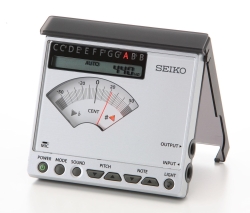 A pitch pipe, piano or correctly tuned guitar will give you the notes you need. Play the target note and try to match it with your bent note. This is a good method as you are developing your musical ear at the same time. There are also many tutorial CD’s that will give you the notes you need. But if you’re worried about whether your bent note is scientifically accurate, then you can buy an electronic tuner. There are many types; we use a SEIKO Chromatic Tuner Model SAT1100 that uses
A pitch pipe, piano or correctly tuned guitar will give you the notes you need. Play the target note and try to match it with your bent note. This is a good method as you are developing your musical ear at the same time. There are also many tutorial CD’s that will give you the notes you need. But if you’re worried about whether your bent note is scientifically accurate, then you can buy an electronic tuner. There are many types; we use a SEIKO Chromatic Tuner Model SAT1100 that uses 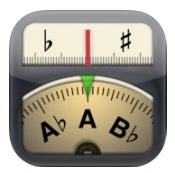 two AAA batteries. You can find it on Amazon and eBay. Otherwise, for Apple iPad users, there’s the Cleartunes app, which is a cheaper option and just as good. But you could always save your money, play songs that require bent notes and use your ears to judge whether or not you’re playing accurately. Or better still, record yourself and listen back. You’ll be surprised by what you hear; no accurate bends, no tune!
two AAA batteries. You can find it on Amazon and eBay. Otherwise, for Apple iPad users, there’s the Cleartunes app, which is a cheaper option and just as good. But you could always save your money, play songs that require bent notes and use your ears to judge whether or not you’re playing accurately. Or better still, record yourself and listen back. You’ll be surprised by what you hear; no accurate bends, no tune!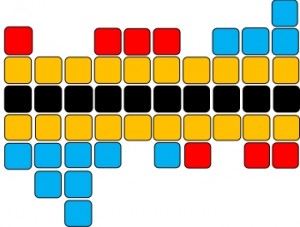 Part One
Part One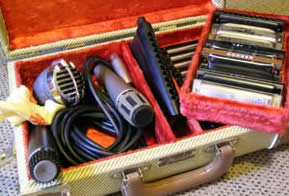 It’s when you alternate (move back and forth) rapidly between two adjacent holes. Trills can be achieved by puckering or tongue blocking. I find puckering best for control, but remember seeing an interview with James Cotton in which he cites Little Walter’s tone when playing tongue-blocked trills as totally ground breaking.
It’s when you alternate (move back and forth) rapidly between two adjacent holes. Trills can be achieved by puckering or tongue blocking. I find puckering best for control, but remember seeing an interview with James Cotton in which he cites Little Walter’s tone when playing tongue-blocked trills as totally ground breaking.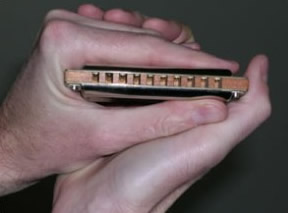 This starts by cupping the harp, which is when we use both hands to create an airtight chamber around the harp. It actually amplifies the sound and gives it a warmer tone. In terms of physics, we are harnessing waveforms and using them to our advantage. The image (left) illustrates the cupped hand hold for acoustic harp playing.
This starts by cupping the harp, which is when we use both hands to create an airtight chamber around the harp. It actually amplifies the sound and gives it a warmer tone. In terms of physics, we are harnessing waveforms and using them to our advantage. The image (left) illustrates the cupped hand hold for acoustic harp playing.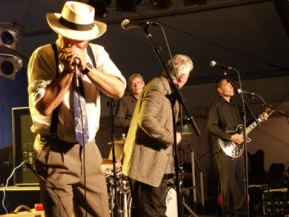 Here are a couple of simple techniques that will elevate your phrasing and musical expression. Call them musical ornamentation.
Here are a couple of simple techniques that will elevate your phrasing and musical expression. Call them musical ornamentation.